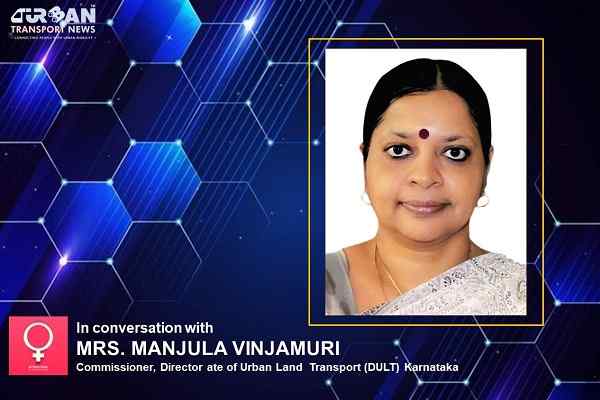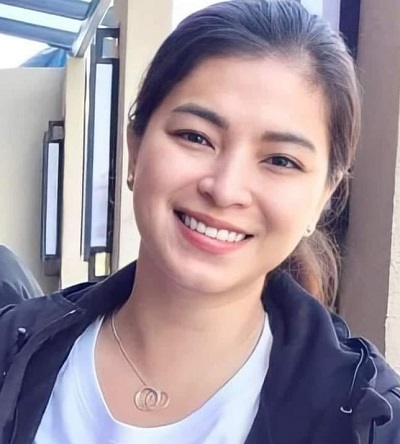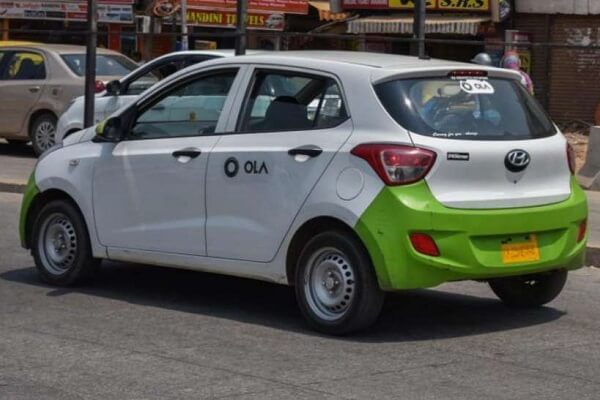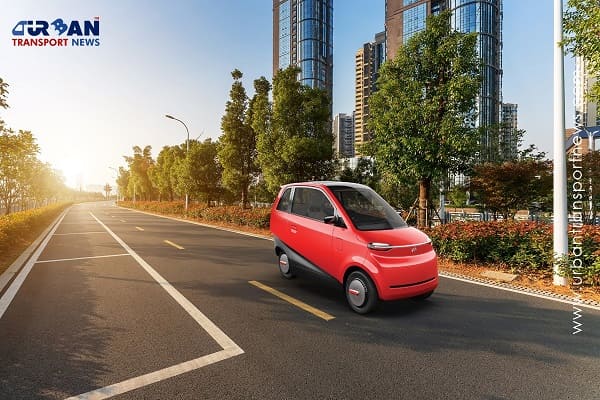 Delhi unveils ambitious Urban Mobility Vision: Luxury Metro Coaches, New Tunnels and Pod Taxi
Delhi unveils ambitious Urban Mobility Vision: Luxury Metro Coaches, New Tunnels and Pod Taxi Qatar approves Saudi Rail Link Agreement, Accelerating Gulf Railway Vision 2030
Qatar approves Saudi Rail Link Agreement, Accelerating Gulf Railway Vision 2030 UP Govt plans to introduce Water Metro services in Ayodhya, Varanasi & Prayagraj
UP Govt plans to introduce Water Metro services in Ayodhya, Varanasi & Prayagraj India’s First Urban Ropeway begins Trial Run in Varanasi, Set to carry 1 Lakh passengers daily
India’s First Urban Ropeway begins Trial Run in Varanasi, Set to carry 1 Lakh passengers daily India and Bhutan to Build First-Ever Rail Link: ₹4,033 Cr Project to Boost Regional Connectivity
India and Bhutan to Build First-Ever Rail Link: ₹4,033 Cr Project to Boost Regional Connectivity Patna to launch Eco-Friendly Water Metro; Trial Run soon between Digha and Kangan Ghats
Patna to launch Eco-Friendly Water Metro; Trial Run soon between Digha and Kangan Ghats Air India Group set to launch Flights Operations from Navi Mumbai International Airport
Air India Group set to launch Flights Operations from Navi Mumbai International Airport Chennai to launch 25-Year Mobility Plan with Unified QR Ticketing and One-App Transit System
Chennai to launch 25-Year Mobility Plan with Unified QR Ticketing and One-App Transit System Kochi Metro bags ₹4.4 crore contract to prepare DPR for Mumbai Water Metro Proejct
Kochi Metro bags ₹4.4 crore contract to prepare DPR for Mumbai Water Metro Proejct Navi Mumbai International Airport set for September launch; IndiGo and Akasa Air to lead Operations
Navi Mumbai International Airport set for September launch; IndiGo and Akasa Air to lead Operations
Interview: Meet Manjula Vinjamuri, A Women Leaders in Urban Transport

As the Commissioner of Directorate of Urban Land Transport (DULT) Karnataka, Ms. Manjula Vinjamuri is one of the most prominent female faces in the Indian transport sector. She worked in diverse sectors like rural and urban development, power, information technology and biotechnology, urban transport, education (including medical education and administrative reforms), as well as the training department of the Government of Karnataka. Apart from her leadership role at DULT, she also holds the positions of Ex-officio Additional Chief Secretary to Government, and Director General, Administrative Training Institute, Mysuru.
After completing her post-graduation in Organic Chemistry from the Osmania University, Hyderabad, Ms. Manjula was selected for the Indian Administrative Service in 1987. During her tenure in various positions, she has played a significant role in formulating policies like the State Start-up Policy, Animation and Visual Graphics Policy, Transit-Oriented Development Policy, and Parking Policy. Her diverse portfolio includes the preparation of district - level human development reports, as well as implementing public awareness campaigns on total literacy and the “Cycle Day” to popularise cycling as the preferred mode for short urban commutes. She has also implemented information technology-based reforms, including online registration for birth and death certifications in rural areas, hospital information systems in medical colleges, launching an e-office in Karnataka's secretariat and subordinate offices, and introducing consent awards for the acquisition of land in rural and urban areas.
With her formidable experience in policymaking, transport planning, and technology-based reforms, Ms Manjula is a role model for many women aspiring to join the administrative services or the transport sector. We have invited her to share her words of wisdom and talk about her personal journey.
How did your early years help you prepare for the various leadership roles you have undertaken over the years?
As the Commissioner, Urban Land Transport at the Directorate of the Urban Land Transport (DULT), Government of Karnataka, my primary focus has been to promote sustainable urban mobility initiatives in Karnataka. At DULT, we plan, design and commission people-centric mobility projects, for which we collaborate with academia, civil society and other government stakeholders like municipal corporations and public transport operators. We also promote innovation and research in urban mobility and provide policy support to the Government.
A leader must be intuitive, creative, be able to lead by example, and never be afraid of taking tough decisions.
My formative years in service equipped me with the skills and confidence needed for dealing with and managing complex issues innovatively.
As an officer of the Indian Administrative Service, I have worked in sectors like rural development, energy, information technology, planning and land administration. My experience in the districts working on maintenance of law and order as well as land management has given me a good grounding in public engagement. As the first Managing Director of two government companies, I had to build these organisations from scratch. This experience stood a good stead when I was posted to DULT. Before DULT came into existence, there were hardly any transport planners in the Government. It started as a unique set up and had to chart its own course and develop meaningful linkages with other players in the mobility ecosystem.
What challenges have you faced in your journey in transport as a woman?
The biggest challenge was to build an incipient organisation into an institution known for credibility and competence. In an ecosystem with a surfeit of departments and organisations, DULT had to be professionally adept in the way it approaches issues and deals with them, for it to be relevant. Learnings from a similar experience in building institutions and a committed team made it possible.
In my experience, women's projects and proposals are only taken into account if they formulate them forcefully and pursue them persistently.
It was a struggle to get approval and funding for the implementation of a bus rapid transit system in a tier-2 city in Karnataka even though funding was freely made available to less effective initiatives. I had to present my case for its implementation to several committees and put forth various analyses to justify why it was needed, and my rationale for seeking funding support and approval.
In my experience, women's projects and proposals are only taken into account if they formulate them forcefully and pursue them persistently. I have not noticed any requirement of a similar effort on the part of men.
Why do we see fewer women leaders in transport and what are the challenges that specifically act as barriers for women to reach management positions? Do you think having more women at the leadership level can play a key role in making transport systems safer and more inclusive?
The representation of women in the transport sector reflects the overall representation of women in leadership positions across all domains and sectors. Women leaders generally get slotted to social sectors like education and health, though fortunately in Karnataka, we had at least two or three women managing directors of public transport companies. The situation is slowly changing, and new opportunities are opening for women leaders. One way to groom more women leaders in transport is through ensuring more women are recruited at various levels and giving them opportunities to handle varied responsibilities and investing in their capacity building. At DULT, we have proactively recruited more women; the proportion of women in our technical workforce is around 50-60%.
Women bring in a different perspective to the way transport systems are run.
Women bring in a different perspective to the way transport systems are run, but I would not like to generalise and say that having them in key positions would automatically make transport systems inclusive and safer. Sensitisation is needed for men and women alike.
Do you think women leaders are more considerate of gender-sensitivity in their approach while planning and implementing projects?
In general, having more women at the planning, implementation and decision-making level will make a significant difference. Women at these levels can bring in a more nuanced approach to designing and implementing projects, considering the needs and concerns of women, children and the elderly.
Many cities are taking initiatives to include women in their workforce, especially as drivers and conductors. While we have seen an increase in women conductors, the same hasn’t been observed for women drivers. What steps do you think are necessary to further promote this change?
Women are now making a mark in highly technical and complex domains like Artificial Intelligence. Therefore, there is no reason why we could not have more women drivers in the transport systems. In Bengaluru’s metro, for example, 38% of metro drivers are women. There is no restriction that impedes women from applying as bus drivers. However, not many apply. There are only two women drivers in Bengaluru’s bus transport system, and both have preferred to work in depots. Women themselves need to be trained and oriented to look at all jobs as equal. The work schedules may need to be adjusted to suit the convenience of women drivers as women have to discharge a larger share of domestic responsibilities.
What changes in policies/infrastructure/incentives may inspire more women to join the transport sector at all levels? What are the initiatives that you have taken or plan to undertake in the future for inclusion of all genders in the transport sector?
DULT is a planning organisation and is not directly concerned with the management and recruitment policies of the public transport undertakings. However, we have tied up with the Indian Institute of Science, Bengaluru to collect and analyse data and come up with policies that could promote Gender Smart and Gender Astute transport systems, not just in Bengaluru but across Karnataka. We would like to make informed decision-making based on the insights garnered from this research project. Many women are graduating as transport planners and the cadre and recruitment policies of mobility stakeholders must reserve appropriate percentage of posts for women transport planners.
Many studies have identified the travel experiences of women as a barrier for them to take up work opportunities. The issues they face range from safety and convenience, to cost and accessibility. How do you think we can resolve this issue? Can digital technology act as an opportunity for the same?
Unfortunately, many public transport systems do not collect gender-disaggregated data and are not well-informed about the mobility patterns of women, their preferences and the challenges they face. Putting in mechanisms to get periodic data on these aspects would greatly help in framing and implementing policies to make our public transport systems convenient and comfortable for women.
Digital technology-based systems/platforms like Mobility as a Service (MaaS) could help us to gather insights on travel preferences of different personas of women, for example, women travelling with elderly or elderly women with their grandchildren. Technological solutions could also provide women with options to trigger alarms, alert control rooms etc. when in trouble and thereby, enhance the perception of safety.
Any final words for women in the early stages in the transport sector?
Mobility is “the sector” to be involved with today considering the challenges it throws up and the immense opportunities for innovation. Disruption in terms of the way transport systems are planned, designed, and managed would become the order of the day.
Greater urbanisation in India also requires creative and passionate leaders who build cities that are more liveable, environmentally sustainable and are places for work, life, and fun. There is great potential for personal and professional growth and various opportunities for shaping our cities. Women must equip themselves with skills to manage and manipulate data, and develop an understanding of policymaking, and the application of technology.
***
‘Women Leaders in Transport’ is an interview series initiated by the Indo-German development cooperation project ‘Integrated and Sustainable Urban Transport Systems for Smart Cities in India (SMART-SUT)’ commissioned by the German Federal Ministry of Economic Cooperation and Development (BMZ) and implemented by Deutsche Gesellschaft für Internationale Zusammenarbeit (GIZ) GmbH in cooperation with the Ministry of Housing and Urban Affairs (MoHUA), Government of India.
The interviews are part of the #MindTheGap campaign to celebrate women leaders in the Indian transport sector. The campaign aims to inspire more women to lead the way in making transport systems more inclusive and safer for all.







